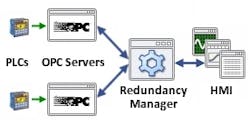Practical tips for planning redundancy in an OPC data communications network
Stated briefly, redundancy for OPC is typically implemented with two redundant OPC servers connected to a single OPC client, through some kind of redundancy manager. When the data from one OPC server becomes unreliable for some reason, the redundancy manager switches to the other OPC server.
Although the concept is straightforward, implementing redundancy in an OPC-based system requires a good understanding of what's at stake. A poorly implemented solution can mean delays, data loss, and overuse of system resources. Whether someone is currently using a redundant system, planning to implement one, or simply wants to broaden their understanding, Cogent's free "Redundancy for OPC" white paper provides useful information.

